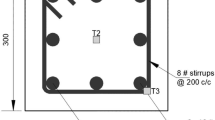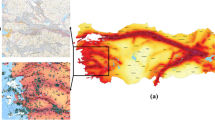Abstract
Structural members experience significant creep deformations in later stages of fire exposure, and are susceptible to failure due to high-temperature creep effects. However, in current practice creep deformations are not fully accounted for in evaluating fire resistance. This paper presents an approach to account for high-temperature transient creep in evaluating fire resistance of reinforced concrete (RC) columns. A three dimensional finite element based numerical model is built in ABAQUS to trace the behavior of RC columns under fire. Temperature induced transient creep strains in concrete and reinforcing steel are explicitly accounted for in the analysis. The model also accounts for temperature induced degradation in concrete and reinforcing steel, and material and geometrical nonlinearities. The model is applied to evaluate the effect of high-temperature creep on the response of fire exposed RC columns. Results from the analysis clearly indicate that high-temperature transient creep significantly influence the extent of deformations when the temperatures in concrete exceed 500 °C, and this in turn influences failure time of RC columns. Thus, neglecting temperature dependent transient creep strains can lead to underestimation of predicted deformations and this can result in un-conservative fire resistance estimation in RC columns.










Similar content being viewed by others
Abbreviations
- σ :
-
Applied stress
- σ s :
-
Stress level
- \(f_{\text{c}}^{\prime }\) :
-
Concrete strength at ambient temperature
- \(f_{{{\text{c}}T}}^{\prime }\) :
-
Concrete strength at temperature T
- f ci :
-
Pre-applied stress
- E :
-
Concrete elastic modulus
- ε tr :
-
Transient creep strain
- ε cr :
-
Classical steady-state creep strain
- (ε tr + ε cr):
-
Transient creep strain
- ε th :
-
Thermal expansion stain
- ε 0.3 :
-
Transient strain at stress level of 30 %
- ε :
-
Emissivity
- k tr :
-
Constant for Anderberg’s model
- g :
-
Function for Schneider’s model
- ϕ :
-
Function for Schneider’s model
- φ :
-
Function for Schneider’s model
- ω :
-
Moisture content
- f(T):
-
Function for Diedrich’s model
- C 1, C 2, C 3 :
-
Constants for Schneider’s model
- V a :
-
Aggregates volume fraction
- σ s :
-
Stefan-Boltzman constant
- α c :
-
Convection coefficient
- t :
-
Time
- T :
-
Temperature
- δ :
-
Friction angle in degrees
- β :
-
Dilation angle in degrees
References
Anderberg Y, Thelandersson S (1976) Stress and deformation characteristics of concrete at high temperatures. 2. Experimental investigation and material behaviour model. Bulletin of Division of Structural Mechanics and Concrete Construction, Bulletin, vol 54
Khoury GA, Grainger BN, Sullivan PJ (1985) Transient thermal strain of concrete: literature review, conditions within specimen and behaviour of individual constituents. Mag Concrete Res 37:131–144
Youssef MA, Moftah M (2007) General stress–strain relationship for concrete at elevated temperatures. Eng Struct 29:2618–2634
Li L, Purkiss J (2005) Stress–strain constitutive equations of concrete material at elevated temperatures. Fire Saf J 40:669–686
Schneider U (1988) Concrete at high temperatures—a general review. Fire Saf J 13:55–68
Schneider U (1986) Modelling of concrete behaviour at high temperatures. In: Design of structures against fire. Elsevier applied science publishers, Aston University, Birmingham, pp 53–69
Khoury GA, Grainger BN, Sullivan PJ (1985) Strain of concrete during first heating to 600 C under load. Mag Concr Res 37:195–215
Terro MJ (1998) Numerical modeling of the behavior of concrete structures in fire. ACI Struct J 95:183–193
Kodur VKR, Dwaikat MMS (2010) Effect of high temperature creep on the fire response of restrained steel beams. Mater Struct 43:1327–1341. doi:10.1617/s11527-010-9583-y
Schaffer EL (1992) Structural fire protection. American Society of Civil Engineers (ASCE), New York
European Committee for Standardization (2004) EN 1992-1-2: Eurocode 2: design of concrete structures—Part 1–2: general rules—structural fire design. Brussels, Belgium
Gernay T, Franssen J-M (2012) A formulation of the Eurocode 2 concrete model at elevated temperature that includes an explicit term for transient creep. Fire Saf J 51:1–9. doi:10.1016/j.firesaf.2012.02.001
Sadaoui A, Khennane A (2012) Effect of transient creep on behavior of reinforced concrete beams in a fire. Mater J 109:607–616
Gao WY, Dai J-G, Teng JG, Chen GM (2013) Finite element modeling of reinforced concrete beams exposed to fire. Eng Struct 52:488–501. doi:10.1016/j.engstruct.2013.03.017
Wei Y, Au FTK, Li J, Tsang NCM (2016) Effects of transient creep strain on post-tensioned concrete slabs in fire. Mag Concr Res. doi:10.1680/jmacr.15.00266
Bratina S, Čas B, Saje M, Planinc I (2005) Numerical modelling of behaviour of reinforced concrete columns in fire and comparison with Eurocode 2. Int J Solids Struct 42:5715–5733. doi:10.1016/j.ijsolstr.2005.03.015
Sadaoui A, Khennane A (2009) Effect of transient creep on the behaviour of reinforced concrete columns in fire. Eng Struct 31:2203–2208. doi:10.1016/j.engstruct.2009.04.005
Huang S-S, Burgess IW (2012) Effect of transient strain on strength of concrete and CFT columns in fire—Part 2: simplified and numerical modelling. Eng Struct 44:389–399. doi:10.1016/j.engstruct.2012.05.052
Mehta PK, Monteiro PJ (2006) Concrete: microstructure, properties, and materials. McGraw-Hill, New York
Williamson RB (1972) Solidification of Portland cement. Progr Mater Sci 15:189–286. doi:10.1016/0079-6425(72)90001-1
Bazant ZP, Prasannan S (1989) Solidification theory for concrete creep. I: formulation. J Eng Mech 115:1691–1703
Bazant ZP, Prasannan S (1989) Solidification theory for concrete creep. II: verification and application. J Eng Mech 115:1704–1725
Kodur VKR, Dwaikat MMS, Dwaikat MB (2008) High-temperature properties of concrete for fire resistance modeling of structures. ACI Mater J 105:517–527
Terro MJ (1991) Numerical modeling of thermal and structural responses of reinforced concrete structures in fire. PhD dissertation, Department of Civil Engineering, Imperial College, London
Khoury GA, Dias WP, Sullivan PJE (1986) Deformation of concrete and cement paste loaded at constant temperatures from 140 to 724 c. Mater Struct 19:97–104
Nielsen CV, Pearce CJ, Bićanić N (2002) Theoretical model of high temperature effects on uniaxial concrete member under elastic restraint. Mag Concr Res 54:239–249. doi:10.1680/macr.2002.54.4.239
Lubliner J, Oliver J, Oller S, Oñate E (1989) A plastic-damage model for concrete. Int J Solids Struct 25:299–326. doi:10.1016/0020-7683(89)90050-4
Lee J (1998) Plastic-Damage model for cyclic loading of concrete structures. J Eng Mech 124:892–900. doi:10.1061/(ASCE)0733-9399(1998)124:8(892)
Williams-leir G (1983) Creep of structural steel in fire: analytical expressions. Fire Mater 7:73–78. doi:10.1002/fam.810070205
Drucker DC, Prager W (1952) Soil mechanics and plastic analysis or limit design. Q Appl Math 10:157–165
Systèmes D (2014) ABAQUS, 6.14 ed. Providence
Lie TT, Lin TD, Allen DE, Abrams MS (1984) Fire resistance of reinforced concrete columns. National Research Council Canada, Ottawa
Kodur VKR, Cheng FP, Wang TC, Latour JC, Leroux P (2001) Fire resistance of high-performance concrete columns. National Research Council Canada, Ottawa
American Concrete Institute (2014) Building code requirements for structural concrete and commentary (ACI 318-14). American Concrete Institute, Framington Hills
ASTM E05 Committee (2014) Test methods for fire tests of building construction and materials. ASTM International, West Conshohocken
Author information
Authors and Affiliations
Corresponding author
Rights and permissions
About this article
Cite this article
Kodur, V.K.R., Alogla, S.M. Effect of high-temperature transient creep on response of reinforced concrete columns in fire. Mater Struct 50, 27 (2017). https://doi.org/10.1617/s11527-016-0903-8
Received:
Accepted:
Published:
DOI: https://doi.org/10.1617/s11527-016-0903-8




